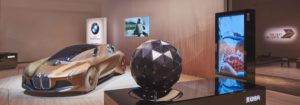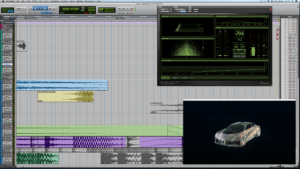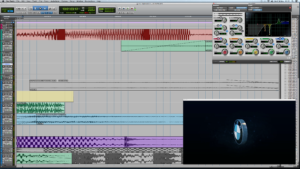VR Sound Design: BMW’s #Next100
Simon Epstein is one of our very talented sound designers. His career began nine years ago at Molinare, – a large film and TV post production house based in Soho. He has worked as a lead Foley Recordist, Mixer, Sound Editor and Department Supervisor providing sound work for Moon, Misfits, Silent Witness, New Tricks, The Hour, and Poirot amongst many other great projects. He became a freelancer in 2012.
What about the BMW #Next100 project interested you?
The BMW #Next100 project wasn’t just an opportunity to celebrate the pioneering achievements of their past, but also to look forward into the future with the BMW Vision Next 100: their new vision vehicle in an Interactive Experience.
Since freelancing, my work has largely been focused on bespoke Sound Design for Animation/3D/Motion Graphics material, within the advertising, branding, and corporate spheres, so this project was well within my remit. When I was asked to contribute to the BMW project, I knew upon first looking at a draft version of the hologram that the design work needed to be special. The project encapsulated the notion of looking to the future; an important concept for us all.
Was the animation sequence complete when you began designing the audio?
I was brought on board in the later stages of animation when the sequence was not yet complete. After sending a first pass of the audio back to the client, there were further changes made to the animation, which meant timing changes. Given the rhythmical nature of the sound design, it was not an easy task to re-cut and move the sound elements and have them work the way they were originally intended. Sometimes though, this can yield fortunate surprises and inspire new ideas, so although technical, the process can be useful.

BMW’s ‘The Next 100’ event – held at Camden Roundhouse
What was your inspiration for the audio?
Given that the piece was created for an event celebrating BMW’s 100 year history, and imagining the next 100 years of innovation, my inspiration was largely centred on the idea of innovation in manufacturing – think robotics, mind-boggling circuitry, and high-tech materials. I used a lot of metal-sounding, staccato notes because aesthetically speaking, my aim was to create something unquestionably modern and design centric. I also wanted to recognise the era of industry and manufacturing, with both sectors cohering to the overall message of the event: progress and innovation in development.
Was this your first VR project?
This is in fact my first VR project, and I very much look forward to the next one! In the past I have worked on video games, AR projects, and immersive Audiovisual Art Installations – so this is an area in which I feel very much at home!
What is your process of creating audio for VR projects?
It all starts with consultation. The client discusses their aesthetic concepts for the piece and then I interpret and execute the audio as I feel appropriate, as was the case with the BMW hologram.
Often with this type of work, the audio will need to be ‘adaptive’, meaning it needs to integrate into the code of the VR programme and thus to stretch, twist, morph, or otherwise transform in accordance with what’s happening visually. This can influence the time/frequency/timbral planes, or any combination of these, simultaneously. It is in this way that Audio Design for VR is much like that of gaming – many extra dimensions need to be considered and thoughtful file preparation and delivery is of crucial importance. The BMW piece however, was of fixed duration and was simply a case of looped playback – therefore the audio was designed to accommodate this.
What factors need to be considered when working within the manufacturing industry? Did you encounter any issues?
A factor that certainly needs considering is how faithful you will remain to the machine sounds. I have worked within the manufacturing industry before, and where possible, I opted to use location recordings. I have often found however, that something I have designed from scratch may be far more exciting, sonically speaking, than the sounds the machines actually make. Often these are far less impressive sounding that you might imagine. A happy medium would be to combine with some extra layers for some added vivacity!


Simon’s ProTools session for BMW’s VR animation
Did you use library tracks or design the entire audio from scratch?
The entire piece was created from the ground up as is usually the case in my work. Over the years I have built up a huge library of my own custom created sound effects, and this is always my first port of call. There are two main reasons for this:
a) This means that I have my own sonic signature on all of my work, and thus stand out from the crowd, and:
b) It enables me to be quicker on projects as I created these effects specifically to be further manipulated and warped. I know exactly what I have in my library and how best to utilise each sound in different scenarios.
What software do you use?
I use ProTools for almost all my sound to moving image work; quite simply, it’s an industry standard and for good reason. As far as audio manipulation and post processing is concerned, unfortunately my sonic arsenal shall remain a closely guarded secret!
To see other elements of post production, visit our showreel gallery!

